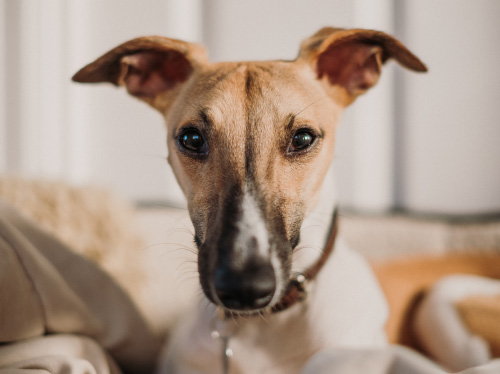
Whippet
Group: Hounds
Origin: Great Britain
Height:
– Males: 19 to 22 inches
– Females: 18 to 21 inches

Photo Copyright ©Mark Raycroft
Provided by: Lepus Reg’d Whippets & Italian Greyhounds
CLICK HERE to View Breeder Listings
Breed Profile
The Whippet was bred in Britain as a result of a careful selection and crossing of small Greyhounds and certain Terriers. His original purpose was to chase and capture small game. Today he is considered one of the most stylish of breeds — equally at home as a family companion or running in races at speeds of up to 35 miles per hour!
He is a medium-sized member of the Sighthound family and looks very similar to the Greyhound, except smaller. He is gentle, sensitive, affectionate, and very calm and quiet when in the home but capable of great stamina when in the sporting mode. The Whippet excels at coursing and racing and his natural athletic talents and quick mind make him ideal for agility, flyball, obedience and disc dog competitions as well.
A devoted and loyal companion, the Whippet, with his trusting and unsuspicious nature, does not make the ideal watch dog as he is generally friendly to strangers.
The close, smooth and firm textured coat is low maintenance and may be of any colour or combination of colours.
Health Issues
The Whippet as a breed is generally healthy and not prone to many of the illnesses that afflict other breeds. They are not prone to ear infections, skin allergies, digestive problems, nor is Hip Dysplasia a problem. The average life expectancy of the Whippet is from 12 to 15 years.
Like all members of the Sighthound family, the Whippet may be sensitive to a number of anesthetics. This should be discussed with your Veterinarian in advance of any required surgery. For additional information, see: Anesthesia in Sighthounds from the Saluki Club of America.
As with any breed, if you are considering the adoption of a Whippet puppy, it is very important to be selective in choosing a responsible and reputable breeder. Because the Whippet breed has been found to have genetic eye problems, on the rare occasion, it is recommended that breeders have the eyes checked on their breeding stock. Ensure that the prospective puppy’s parents have the recommended health clearances. (For more information on selecting a breeder, see the articles on the main General Information page.)
Additional Health Resources:
- Canine Health Information Center (CHIC) — Providing a source of health information for owners, breeders, and scientists that will assist in breeding healthy dogs. CHIC is a centralized canine health database jointly sponsored by the AKC/Canine Health Foundation (AKC/CHF) and the Orthopedic Foundation for Animals (OFA).
- Health and Nutrition — Growing section of the Canada’s Guide to Dogs website which includes information on several health and nutrition related issues.
- AKC Canine Health Foundation — Working towards developing scientific advances in canine health.
- Canine Eye Registration Foundation (CERF)
- Orthopedic Foundation for Animals (OFA)
- Ontario Veterinary College (OVC)
- University of Pennsylvania Hip Improvement Program (PennHip)
- HealthGene — HealthGene Corporation is the leading provider of veterinary DNA diagnostic services in Canada.
- Labgenvet — Laboratory of Veterinary Genetics is a Canadian diagnostic laboratory that offers a comprehensive service of DNA tests for veterinary genetic diseases.

Grooming Information
- Grooming — This section of the Canada’s Guide to Dogs website includes tips, articles and information covering all aspects of dog grooming along with a listing of Groomers from across Canada.
Training Resources
- Training — For training information, see this growing section of the Canada’s Guide to Dogs website for tips, articles, as well as listings of training centres across Canada.
Additional Information
- Clubs, Sports & Activities — This section of the Canada’s Guide to Dogs website covers several sports and activities and also includes listings of non-breed specific Dog Clubs from across Canada.
- Working Dogs — The Working Dogs section of the Canada’s Guide to Dogs website provides information and listings of organizations that are involved in various dog jobs, such as Guide Dogs, Therapy Dogs, Police Dogs, Protection Dogs, and much more.
- Straight & Oval Racing — From The American Whippet Club
- Lure Coursing
- Whippets and Other Sighthounds — A very informative website dedicated to Sighthounds explaining why a Sighthound thinks and acts differently from other breeds of dogs.
*NOTE 1: CHIC – The Canine Health Information Center “is a database of consolidated health screening results from multiple sources. Co-sponsored by the Orthopedic Foundation for Animals (OFA) and the American Kennel Club (AKC) Canine Health Foundation, CHIC works with parent clubs to identify health screening protocols appropriate for individual breeds. Dogs tested in accordance with the parent club established requirements, that have their results registered and made available in the public domain are issued CHIC numbers.” To learn more, visit: www.caninehealthinfo.org
*NOTE 2: The Fédération Cynologique International (FCI) is the World Canine Organization, which includes 91 members and contract partners (one member per country) that each issue their own pedigrees and train their own judges. The FCI recognizes 344 breeds, with each being the “property” of a specific country. The “owner” countries write the standards of these breeds in co-operation with the Standards and Scientific Commissions of the FCI, and the translation and updating are carried out by the FCI. The FCI is not a breed registry nor does it issue pedigrees.
Quick Links
Get In Touch
- Email: canadasguidetodogs@gmail.com
- Email: info@canadasguidetodogs.com
- Visit us on Facebook: www.facebook.com/CanadasGuideToDogs
— CanadasGuideToDogs.com is an Amazon Associate as well as a participant in various affiliate programs, as such fees are earned from qualifying purchases.


